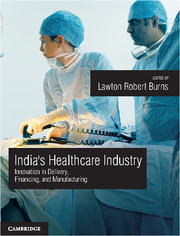Book contents
- Frontmatter
- Contents
- List of Figures
- Preface
- Acknowledgments
- SECTION I Introduction: Lenses and Frameworks for Analyzing India's Healthcare System
- SECTION II Providers: Delivery of Healthcare Services
- SECTION III Payers: Financing of Healthcare Services
- SECTION IV Producers: Manufacturers of Healthcare Technology
- 13 The Indian Pharmaceutical Sector: The Journey from Process Innovation to Product Innovation
- 14 India's Biotechnology Sector
- 15 The Medical Device Sector in India
- 16 Balancing Access and Innovation in Developing Countries
- Contributors
- Index
13 - The Indian Pharmaceutical Sector: The Journey from Process Innovation to Product Innovation
Published online by Cambridge University Press: 05 June 2014
- Frontmatter
- Contents
- List of Figures
- Preface
- Acknowledgments
- SECTION I Introduction: Lenses and Frameworks for Analyzing India's Healthcare System
- SECTION II Providers: Delivery of Healthcare Services
- SECTION III Payers: Financing of Healthcare Services
- SECTION IV Producers: Manufacturers of Healthcare Technology
- 13 The Indian Pharmaceutical Sector: The Journey from Process Innovation to Product Innovation
- 14 India's Biotechnology Sector
- 15 The Medical Device Sector in India
- 16 Balancing Access and Innovation in Developing Countries
- Contributors
- Index
Summary
Overview
Though young, the pharmaceutical sector in India has undergone tremendous transformation over its 52 years of existence since it began to manufacture bulk products. It is currently growing at an annual rate of approximately 12 percent, driven by the dynamics of both global and domestic markets. In order to assess opportunities in this sector, it is important to develop a historical perspective of Indian pharmaceuticals and an appreciation for the current growth drivers.
This chapter begins with a brief overview of the evolution of Indian pharmaceuticals. It then describes the sector and its growth in domestic and international markets, the drivers of that growth, the recent performance of leading pharmaceutical companies, the core advantages that support the performance of Indian companies in the global arena, and merger and acquisition (M&A) trends involving global multinationals. The chapter next examines trends in the market pricing for on-patent drugs (not patented in India), their impact on access and market penetration, and how that translates into opportunities for generic entry. Finally, the chapter uses examples to shed light on the nature of prevailing innovations and the challenges facing the sector as it transitions from process innovation to product innovation and a focus on drug discovery.
History of India's pharmaceutical sector
At the time of India's independence (1947), pharmaceutical multinational companies (MNCs) like today's GlaxoSmithKline (GSK), Johnson & Johnson (J&J), and Pfizer had a near monopoly in the domestic Indian market. They imported completely formulated, finished dosages of generic drugs and sold them at a low cost, along with a few highly priced specialty medicines.
- Type
- Chapter
- Information
- India's Healthcare IndustryInnovation in Delivery, Financing, and Manufacturing, pp. 441 - 476Publisher: Cambridge University PressPrint publication year: 2014
- 1
- Cited by



